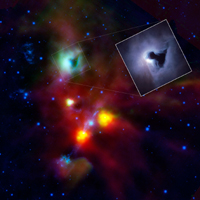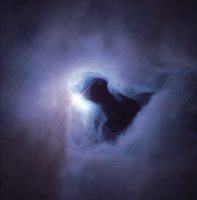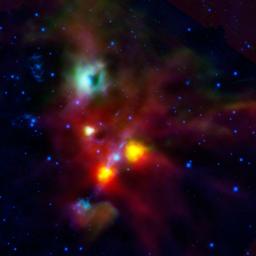 |  |
| Hubble Inset | Larger Hubble Image |
Click on an individual image for larger imageThe dark hole seen in the green cloud at the top of this image was likely carved out by multiple jets and blasts of radiation. The hole was originally thought to be a really dark cloud, but this new infrared picture from the Herschel space observatory and the National Optical Astronomy Observatory on Kitt Peak near Tucson, reveals that the dark spot is actually a gap in a "nest" of gas and dust containing fledgling stars.
An older picture of the hole captured in visible light by NASA's Hubble Space Telescope is shown as an inset. At the time the picture was taken, astronomers thought the hole was a dark cloud. When Herschel looked in its direction to study nearby young stars, astronomers were surprised to see the cloud continued to look black, which shouldn't have been the case. Herschel's infrared eyes are designed to see into such clouds.
The glowing, green cloud around the hole is called NGC 1999. It contains a fairly bright star, called V380 Ori, which is heating up the dust and creating the bright greenish glow. V380 Ori is a triple star system -- one of these three stars appears to have launched a jet that helped clear the hole, as well as other jets and stellar radiation.
The red, filamentary glow extending through the middle of the image is a cloud of cold, dense gas and dust -- the raw material from which new stars are forming. Three new, embryonic stars can bee seen as the triangle of orangish, yellow-white spots. Bipolar jets are visible streaming out of one of these stars in blue. The dark region below and to the right of the top orange-white star of the triangle is thought to be another hole carved by jets from the star. This possible hole is not yet lit up by a star, as is the case with the hole seen above it.
Shorter-wavelength infrared light captured by the "NEWFIRM" camera at the National Optical Astronomy Observatory is colored blue, while longer-wavelength infrared light seen by the photoconductor array camera and spectrometer instrument on Herschel is green and red.
Herschel is a European Space Agency cornerstone mission, with science instruments provided by consortia of European institutes and with important participation by NASA. NASA's Herschel Project Office is based at NASA's Jet Propulsion Laboratory. JPL contributed mission-enabling technology for two of Herschel's three science instruments. The NASA Herschel Science Center, part of the Infrared Processing and Analysis Center at the California Institute of Technology in Pasadena, supports the United States astronomical community. Caltech manages JPL for NASA.
More information is online at http://www.herschel.caltech.edu, http://www.nasa.gov/herschel and http://www.esa.int/SPECIALS/Herschel/index.html.

 Planetary Data System
Planetary Data System














